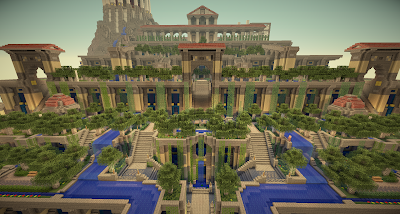 |
| Hanging Gardens of Babylon |
Best places to visit in the USA
The Hanging Gardens of Babylon, one of the Seven Wonders of the Ancient World, is the only one whose location has not been definitively established.The Hanging Gardens were described as a remarkable feat of engineering: an ascending series of tiered gardens containing all manner of trees, shrubs, and vines. The gardens were said to have looked like a large green mountain constructed of mud bricks.Traditionally they were said to have been built in the ancient city of Babylon, near present-day Hillah, Babil province, in Iraq. The Babylonian priest Berossus, writing in about 290 BC and quoted later by Josephus, attributed the gardens to the Neo-Babylonian king Nebuchadnezzar II, who ruled between 605 and 562 BC. There are no extant Babylonian texts which mention the gardens, and no definitive archaeological evidence has been found in Babylon.According to one legend, Nebuchadnezzar II built the Hanging Gardens for his Median wife, Queen Amytis, because she missed the green hills and valleys of her homeland. He also built a grand palace that came to be known as "The Marvel of the Mankind".Because no physical evidence for the Hanging Gardens has be found at Babylon it has been suggested that they were purely mythical, and the descriptions found in ancient Greek and Roman writers including Strabo, Diodorus Siculus and Quintus Curtius Rufus represent a romantic ideal of an eastern garden. If it did indeed exist, it was destroyed sometime after the first century AD.Stephanie Dalley suggests that the original garden may have been a well-documented one that the Assyrian king Sennacherib (704–681 BC) built in his capital city of Nineveh on the River Tigris, near the modern city of Mosul.
Here are the Facts
- The Hanging Gardens of Babylon is a legendary, and possibly mythical, garden part of the Seven Wonders of the Ancient World.
- The Hanging Gardens of Babylon are said to have had large pillars and a number of tiers and terraced levels, and the translation from the Greek and Latin words to describe the garden, more accurately use the word ‘overhanging’ rather than the literally ‘hanging’ garden which is depicted in the garden’s name.
- The Hanging Gardens of Babylon is the only Wonder of the Ancient World that does not have a proven location.
- According to Greek texts, the Hanging Gardens of Babylon is depicted as a lush garden of exotic foliage and wildlife, with man-made waterfalls.
- It has been historically believed that the Hanging Gardens of Babylon were located at the ancient city of Babylon, built by King Nebuchadnezzar II, although there is no Babylonian evidence.
- There are many theories of the location of the Hanging Gardens of Babylon, with a lot of evidence supporting the ‘Hanging Gardens of Nineveh’ theory, and if this is true, the gardens would have been owned by King Sennacherib.
- Some believe that the Hanging Gardens of Babylon were destroyed in an earthquake, although many others believe erosion and conquest were the destruction factors.
- It is believed that the Hanging Gardens of Babylon were built in the 6th or 7th century BC.
- Historians believe that walls of the Hanging Gardens of Babylon were 24 metres (80 feet) in height, approximately the height of five storey building, and were made from a type of brick.
- The height of the Hanging Gardens of Babylon would have required a significant irrigation system, that has been described as an amazing engineering feat.
Best places to visit in the USA
Comments